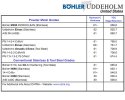We've all heard of steels and edge retention, but I've always wondered if anyone every recorded what steels perform better with a certain edge angle.
For example, does 154CM hold an edge better at 30 degrees or 40 degrees? What edge angle would generally get the best edge retention out of 440A?
I know the edge retention depends on the individual knife and its grind and heat treatment.
For example, does 154CM hold an edge better at 30 degrees or 40 degrees? What edge angle would generally get the best edge retention out of 440A?
I know the edge retention depends on the individual knife and its grind and heat treatment.

